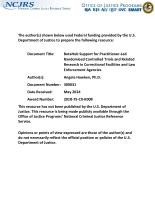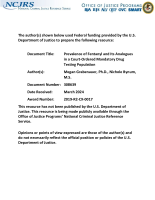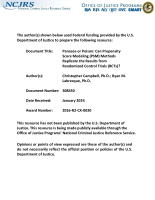Criminal justice research
NIJ Publications Catalog, 1983-89
Advancing Justice for the Missing and Unidentified Through Research - 2024 NIJ Research Conference
Forensic science research is developing essential knowledge to fill in the holes in death investigations, creating new ways to identify challenging skeletal remains. These methods inform cause of death, time of death, and familial relationships to guide investigations, identify suspects, support prosecutions, and bring justice to families.
See the YouTube Terms of Service and Google Privacy Policy
Evaluation of Community-Based Violence Intervention and Prevention Initiatives (CVIPI) in New Haven, CT
A Comprehensive Evaluation and Error Rate Assessment of Field Colorimetric Testing for Seized Drugs
A Focused Deterrence Program for Juveniles with Firearm Offenses: a Randomized Controlled Trial and Process Evaluation
Procedural and Structural Justice Through Causal Understanding, Component Decoupling, and Relation Characterization
Breaking the School-To-Prison Pipeline: Implications of Removing Police from Schools for Racial and Ethnic Disparities in the Justice System
Evaluating a Young Adult Court (YAC) to Address Inequalities for Transitional Age Youth in Orange County
Redesigning Life in U.S. Prisons
The prison system in the U.S. typically places a heavy emphasis on security, control, and punishment, and this foundation can create an adversarial culture within correctional facilities — incarcerated individuals versus correctional staff. But what if that culture could change? What would it look like? How would it impact not only incarcerated individuals but also correctional officers and other staff?
Adult Children of the Prison Boom: Family Troubles and the Intergenerational Transmission of Criminal Justice Contact
BetaHub Support for Practitioner-Led Randomized Controlled Trials and Related Research in Correctional Facilities and Law Enforcement Agencies
Forensic DNA Interpretation and Human Factors: Improving Practice Through a Systems Approach
Closing Cases Using Gunshot Residue
Closing Cases Using Gunshot Residue
Not every crime scene will have definitive evidence, such as DNA, to link an individual to a crime. In those cases, law enforcement relies on other evidence to build the burden of proof. NIJ graduate research fellow Dr. Shelby Khandasammy developed a tool to analyze organic gunshot residue and distinguish between different firearms calibers and manufacturers. She joins Marie Garcia, office director for the Office of Criminal Justice Systems at NIJ, to talk about her work and experience as a research fellow.










